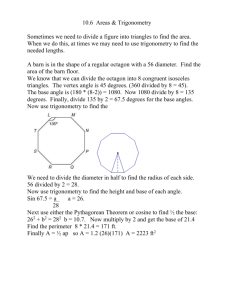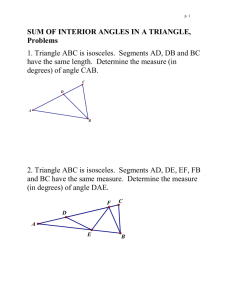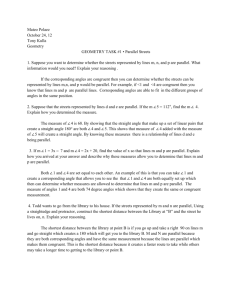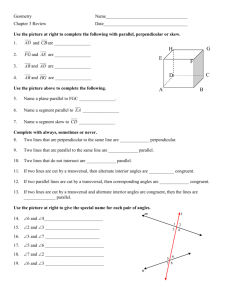CP GEOMETRY – REVIEW NOTES Chapter 5 – Points of
advertisement
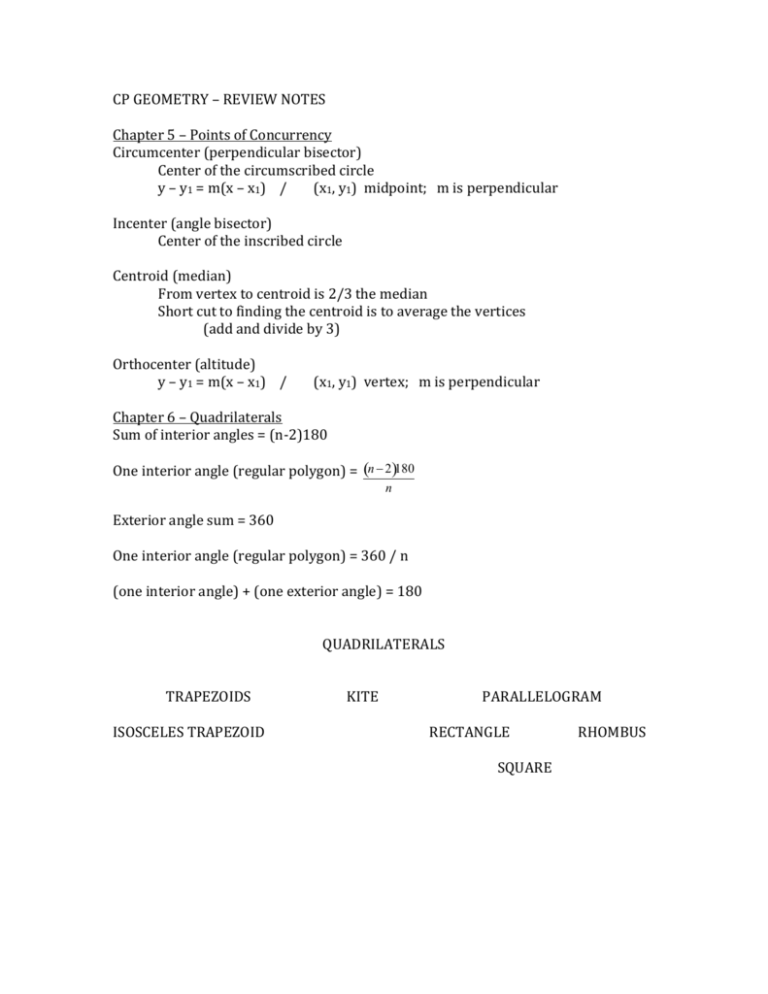
CP GEOMETRY – REVIEW NOTES Chapter 5 – Points of Concurrency Circumcenter (perpendicular bisector) Center of the circumscribed circle y – y1 = m(x – x1) / (x1, y1) midpoint; m is perpendicular Incenter (angle bisector) Center of the inscribed circle Centroid (median) From vertex to centroid is 2/3 the median Short cut to finding the centroid is to average the vertices (add and divide by 3) Orthocenter (altitude) y – y1 = m(x – x1) / (x1, y1) vertex; m is perpendicular Chapter 6 – Quadrilaterals Sum of interior angles = (n-2)180 One interior angle (regular polygon) = n 2180 n Exterior angle sum = 360 One interior angle (regular polygon) = 360 / n (one interior angle) + (one exterior angle) = 180 QUADRILATERALS TRAPEZOIDS ISOSCELES TRAPEZOID KITE PARALLELOGRAM RECTANGLE SQUARE RHOMBUS Quadrilateral – 4 sided polygon Trapezoid – one pair of parallel sides; same side angle supplementary Isosceles Trapezoid – legs congruent; base angles congruent; diagonals congruent Kite – 2 pair of consecutive sides congruent; diagonals perpendicular; non-vertex angles congruent; vertex angles bisected Parallelogram – opposite sides parallel and congruent; opposite angles congruent; consecutive angles supplementary; diagonals bisect each other; if there is 1 right angle then there are 4 right angles Rectangle – 4 right angles; diagonals congruent Rhombus – 4 congruent sides; diagonals are perpendicular Square – ALL OF THE ABOVE AREA FORMULAS trapezoid hb1 b2 2 d1 d 2 2 parallelog ram b h rec tan gle l w d d r hom bus 1 2 2 2 square s kite Chapter 7 – Proportions and Similarity Triangles and polygons are similar if corresponding angles are congruent and corresponding sides are proportional Similarity ratio = perimeter ratio (similarity ratio)2 = area ratio Short Cuts to prove similarity: AA / SSS / SAS Midsegment - segment that connects the midpoints of two sides of a triangle Midsegment is parallel to the third side Midsegment is ½ the third side If a line is parallel to a side of a triangle and intersects two sides of triangle, then CB CD BA DE When triangles are similar, then perimeters, altitudes, medians and angle bisectors are proportional. Chapter 8 – Right Triangles and Trigonometry Pythagorean Theorem – leg2 + leg2 = hypotenuse2 (RIGHT TRIANGLE) Hypotenuse2 > leg2 + leg2 (OBTUSE TRIANGLE) Hypotenuse2 < leg2 + leg2 (ACUTE TRIANGLE) SHORT CUT TRIANGLES 30-60-90 45-45-90 TRIGONOMETRY sin opposite hypotenuse cos adjacent hypotenuse tan opposite adjacent Chapter 11 – Area of Polygons and Circles and Volume AREA FORMULAS trapezoid hb1 b2 2 d1 d 2 2 parallelog ram b h rec tan gle l w d d r hom bus 1 2 2 2 square s kite Regular Polygon = (number of sides)[1/2 (polygon side)(apothem)] Area of Circle = r2 (pi) Volume = (area of base)(height) Chapter 10 – Circles Circumference = (diameter)(pi) Diameter = 2 radius arc o arc length d 360 o If the diameter/radius is perpendicular to a chord, then it bisects both the chord and the intercepted arc A diameter/radius is perpendicular to a tangent at the point of tangency. Two segments tangent to a circle from an exterior point are congruent. ANGLES CENTRAL ANGLE A arc(BC) INSCRIBED ANGLE B 1 arcBD 2 VERTEX ON THE CIRCLE B 1 arcAB 2 VERTEX INSIDE THE CIRCLE BEA arcAB arcCD 2 VERTEX OUTSIDE THE CIRCLE exterior BIGarc LITTLEarc 2 B BIGarcAC LITTLEarcAC 2 C arcAD arcBD 2 C arcAE arcBD 2



